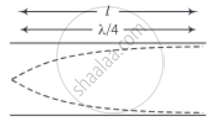Advertisements
Advertisements
Question
A pipe 20 cm long is closed at one end. Which harmonic mode of the pipe is resonantly excited by a source of 1237.5 Hz? (sound velocity in air = 330 ms–1)
Solution
Length of pipe
(Closed pipe)
l = 20 cm = 20 × 10–2m
Hence, 3rd harmonic mode of the pipe is resonantly excited by the source of given frequency.
APPEARS IN
RELATED QUESTIONS
An open organ pipe of length L vibrates in its fundamental mode. The pressure variation is maximum
Two wires are kept tight between the same pair of supports. The tensions in the wires are in the ratio 2 : 1 the radii are in the ratio 3 : 1 and the densities are in the ratio 1 : 2. Find the ratio of their fundamental frequencies.
A 2 m long string fixed at both ends is set into vibrations in its first overtone. The wave speed on the string is 200 m s−1 and the amplitude is 0⋅5 cm. (a) Find the wavelength and the frequency. (b) Write the equation giving the displacement of different points as a function of time. Choose the X-axis along the string with the origin at one end and t = 0 at the instant when the point x = 50 cm has reached its maximum displacement.
Two wires of same material are vibrating under the same tension. If the first overtone of first wire is equal to the second overtone of second wire and radius of first wire is twice the radius of the second then the ratio of length of first wire to second wire is
The transverse displacement of a string (clamped at its both ends) is given by y(x, t) = 0.06 sin (2πx/3) cos (120 πt). All the points on the string between two consecutive nodes vibrate with ______.
- same frequency
- same phase
- same energy
- different amplitude.
Which of the following statements are true for a stationary wave?
- Every particle has a fixed amplitude which is different from the amplitude of its nearest particle.
- All the particles cross their mean position at the same time.
- All the particles are oscillating with same amplitude.
- There is no net transfer of energy across any plane.
- There are some particles which are always at rest.
An organ pipe of length L open at both ends is found to vibrate in its first harmonic when sounded with a tuning fork of 480 Hz. What should be the length of a pipe closed at one end, so that it also vibrates in its first harmonic with the same tuning fork?
Two identical strings X and Z made of same material have tension Tx and Tz in them If their fundamental frequencies are 450 Hz and 300 Hz, respectively, then the ratio
Shown in the figure is rigid and uniform one meter long rod AB held in horizontal position by two strings tied to its ends and attached to the ceiling. The rod is of mass 'm' and has another weight of mass 2m hung at a distance of 75 cm from A. The tension in the string at A is :

A tuning fork of frequency 480 Hz is used in an experiment for measuring the speed of sound (ν) in the air by resonance tube method. Resonance is observed to occur at two successive lengths of the air column, l1 = 30 cm and l2 = 70 cm. Then, ν is equal to ______.
